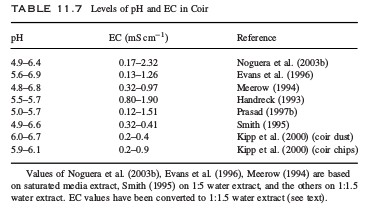Side by side with peat moss, coco coir is one of the most commonly used media in hydroponic culture. Its excellent root propagation and aeration properties, coupled with its adequate water retention, make it an ideal medium for hydroponic culture. Nonetheless, there are several issues that can arise when using coco coir, particularly due to its chemistry and variability. Today we are going to talk about using coco coir in hydroponics, what the main problems with coco can be and how these problems can be avoided.
Coco coir is basically ground up dried palm tree husks. Although it is organic, it is much more fibrous than peat moss and for this reason, it does not suffer from some of the pH and decomposition issues commonly found with peat. Although coco is biodegradable, its decomposition can take more than 20 years, reason why it is a suitable media for hydroponics. It can even be used several times within a hydroponic crop in order to save production costs, as long as plant material is removed and the media is properly treated between crops.
Since coco coir comes from large plants grown across a variety of different conditions, the actual chemical makeup of the coco can change very substantially. The table above shows the pH and EC of different coco coir sources. As you can see, we have everything from an EC of 0.1 mS/cm to an EC of 0.9 msS/cm, with pH values that cover anything from 4.9 to 6.8. This is mainly due to the big variations in the ions contained within the coco and how these ions interact with the plant material.
Coco coir also has a high cation exchange capacity, meaning that it can retain large amounts of ions. These are only taken out if they are replaced by others with stronger affinity for the media or when strong interactions with chelating agents are possible. This is generally why coco is treated with calcium nitrate solutions, to remove many of these ions from the media structure and allow the media to be as neutral as possible when used in hydroponic culture. However, many coco producers do not treat the media at all – or simply wash it with plain water – leaving a lot of potassium and sodium within the coco that needs to be accounted for. A lot of micro nutrients that are tightly bonded to cation exchange sites are often also often present inside the coir.


If you want to ensure your coco is as neutral as possible in terms of nutrients, you can extract it with a 1 g/L solution of calcium nitrate and then with 2g/L of tetrasodium EDTA. This will extract both macronutrients that are exchangeable for Calcium, and micro nutrients that can be extracted when using EDTA. The EDTA step is important, as coco can hold a large amount of micro nutrients within it, that can be exchanged and used by the plant. If you want your nutrients to all come from solution you will need to remove these contributions from the media. After this, you will then want to run plain water to remove any excess Ca and EDTA and then run your full strength nutrient solution for a few days. This will strip the coco from excess ions and equilibrate the cation exchange sites with your nutrient solution’s composition.
Note that these steps aren’t necessary to grow successfully with coco, but they can give the grower more control over the nutrients received by the plants. You can alternatively run nutrient solution through the coco and then perform an analysis of the output, so that you can compensate for the nutrients that are given by the coco through the growth cycle. This of course means that you need to spend money doing solution analysis through the crop’s life to ensure that you’re adequately compensating for the coco’s contributions through the entire growing period.
When properly treated, coco can be a very good media for growing hydroponic crops. The larger aeration, better chemical stability and fibrous structure makes it better for root growth than most peat moss sources. Yields for several plants are also often larger or just as good in coco when compared with peat moss. The lack of important decomposition during growth cycles is also a big advantage over peat, as important drops in pH due to media decomposition can be avoided and the media can be more readily recycled.






